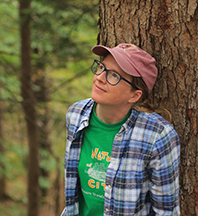Week of August 10, 2025 – August 16, 2025

by Anna Stunkel, Environmental Educator
After a sweltering summer day, you might enjoy spending some time outdoors in the cool night air. Night is a lovely time to have a cookout, enjoy a summer park concert, or search for nocturnal critters who are also active. About a week ago, we set up black lights for our night buggin’ program at Baltimore Woods. Any time that we interrupt the darkness with human-made lights, it’s important to be mindful of how this impacts nature. As we marveled at moths, caterpillars, and caddisflies last weekend, our setup included a few small black lights spaced out between the pavilion and nearby forest. This is not something that we do often, so predators don’t get too used to hanging around the lights in search of a buggy snack.
If you zoom out to a larger scale and consider light pollution from homes and businesses, then cities and towns, we see a much broader impact. This is especially important to consider in mid-August as nocturnal bird migration begins in Central New York. Many songbirds migrate under cover of darkness to sneak past daytime predators. But in a changing world, they face new challenges. Office buildings shine bright lights through curtainless windows, cell towers blink, and sports stadiums cast spotlights into the sky. Of course, we need some lighting so our communities avoid problems like vehicle accidents. However, like many things created by humans, nighttime lighting can be excessive.
These lights are disorienting, often causing birds to collide with buildings and other structures. Light pollution alters their view of the stars, which birds use for navigation. One to two billion birds per year die in building collisions in the US. Lights also attract insects, and on a larger scale this can cause unnatural predation levels. Light disrupts how amphibians like frogs and toads call, too.
What can we do to help? Particularly during peak bird migration (August 15- November 15 and April 1- May 31 in Central New York), turn off unnecessary lights between 11 pm and 6 am. These are also times when many summer insects and amphibians are active. If you need nighttime lighting, you can reduce its impact by shielding and dimming lights, installing motion sensors, and using lights with warmer tones. To learn more about the Lights Out Central New York project, and to find more ways to help in your community, check out the project’s website here! This project has recently started in partnership with Onondaga Audubon, and it is growing quickly thanks to dedicated volunteers and ESF students.
Next time you’re out enjoying a summer night in an environment where you feel safe, try to be quiet and unobtrusive like a fox, and use your senses as you are able. Turn off lights and let your eyes adjust to the darkness, listening to katydid and treefrog calls around you. Look up at the night sky and see if you can spot any constellations. As we value the beauty and mystery of nighttime, we must work to keep it safe for our critter friends, too.

